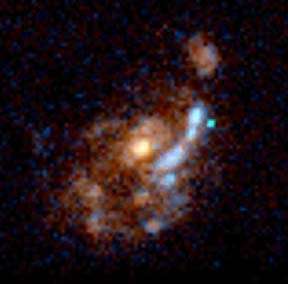Are ultra-luminous galaxies colliding?

(Phys.org) —ltra-luminous infrared galaxies ((ULIRGs) are galaxies whose luminosity exceeds that of a trillion suns, By way of comparison, our Milky Way galaxy has a typical modest luminosity of only about ten billion suns. ULIRGs were discovered by an all-sky infrared survey satellite in the 1980's, and since then the origin(s) of their powerful emission has been widely debated. Extreme infrared activity is known to be associated with interacting galaxies, and optical imaging shows that many ULIRGs are indeed in collision. The two primary known sources of global energy production in galaxies are star formation and accretion activity around a massive black hole in the nucleus (a so-called active galactic nucleus). Both of them produce radiation that heats up the dust. Mergers might result in intense infrared emission.because they help to drive this kind of active star formation.
The issue takes on an even sharper focus because earlier in our universe - about ten billion years after the big bang when most of the stars in the current universe were formed - some evidence suggests that ultra-luminous galaxies are not merging - implying that the dominant star formation mechanisms did not involve mergers. These distant, bright galaxies are rich in molecular gas among other features, for example, and perhaps their active star formation has little to do with the merger scenario? Either way it remains unclear exactly what physical mechanisms power the luminosity. Determining whether these galaxies are in fact colliding or not is difficult because merging galaxies are identified by morphological distortions in their shapes, and in distant galaxies such distortions are difficult to see.
CfA astronomers Chao-Ling Hung and Howard Smith joined with their colleagues to study a selection of 2084 infrared luminous galaxies using the Advanced Camera for Surveys on the Hubble Space Telescope. Using quantitative measures of galaxy distortion, they conclude that, contrary to some earlier suggestions, there is no significant evidence that most distant ULIRGs are less involved in mergers than local ones; only a slight 20% decrease is detected. The result challenges conventional wisdom and, if confirmed, would mean that the processes driving star formation have not changed much in the past few billion years.
More information: "Comparison of the Morphological Properties Between Local and Z 1 Infrared Luminous Galaxies. Are Local and High−Z (U)LIRGS Different?" Chao-Ling Hung, B. Sanders, Caitlin M. Casey, Michael Koss, Kirsten L. Larson, Nicholas Lee, Yanxia Li, Kelly Lockhart, Hsin-Yi Shih, Joshua E. Barnes, Jeyhan S. Kartaltepe, and Howard A. Smith, ApJ 2014 (in press)
Provided by Harvard-Smithsonian Center for Astrophysics





















